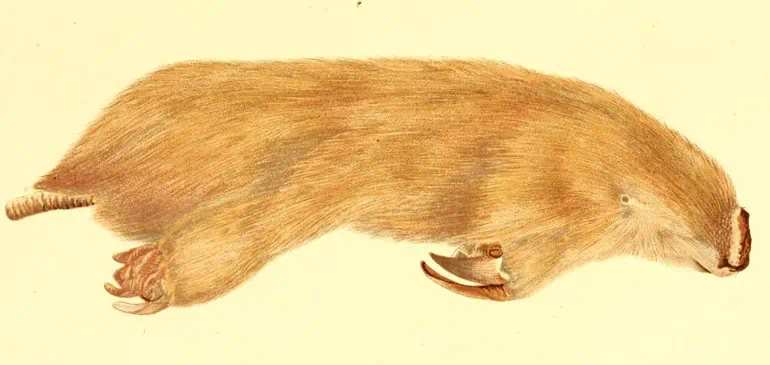Marsupial Mole
The Southern Marsupial Mole’s scientific name is Notoryctes typhlops. Aboriginal people of the Western Desert call it Itjaritjari (great sounding name!).
It is not a ‘mole’, but a small, unusual pale gold marsupial with no visible eyes or ears. It has a short leathery tail, and a horny calloused shield protects its nose. The tiny marsupial grows up to 15 cm (6 inches), weighs about 70 grams ( 2.5 ounces), and can fit easily into the palm of your hand. The Northern Marsupial Mole (Notoryctes caurinus) also differs ever so slightly from typhlops.
The Southern Marsupial Mole is classified as ‘endangered’ in W.A. and ‘vulnerable‘ in S.A. and N.T. Few have been recorded in the last 50 years compared with the previous century. Little is known about their life underground and they don’t survive in captivity for very long.
The image above shows a surfaced mole in the dunes near Uluru. In the ‘wake’ behind the animal, the sand ripples as it ‘swims’ through the sand. The itjaritjari inhabits dunes and adjacent swales with suitable deep, loose sand. They do not spend much time on the surface but swim in the sand, backfilling as they progress. They breathe the air that flows between sand grains and generally only comes up after heavy rain. The claws on its front feet are like spades, so when burrowing, it moves them up and down in a chopping action, and the hind feet push pushed out the back. The mole’s stubby tail acts as a lever to move forward.
Their burrows can be 2m (6.5 feet) underground, so they are quite the subterranean travellers. The female’s pouch carry and suckle the young. It opens toward the rear and keeps out sand when digging.
A paper by Natalie Warburton called “Functional morphology and evolution of marsupial moles” (Marsupialia: Notoryctemorphia) from the University of Western Australia has a lot of in-depth information on these highly specialised burrowing marsupials (click on the full-text icon to read the full paper).


